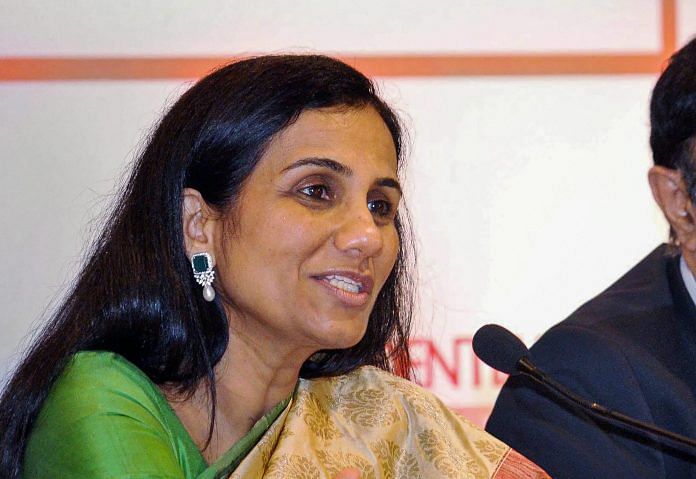Past few weeks has seen exit of 2 more women bankers — Allahabad Bank’s Usha Ananthasubramanian & Axis Bank’s Shikha Sharma, who retires in December.
New Delhi: Over the past decade, a highlight of India’s banking sector was the many women in top management positions. That identity, however, seems to be waning, with several women bankers retiring or stepping down in the past few years, the latest being ICICI Bank’s managing director Chanda Kochhar.
The ICICI board Thursday, in a filing with the Bombay Stock Exchange, said it had accepted her request for early retirement with immediate effect and appointed Sandeep Bakshi as managing director and chief executive.
Kochhar had earlier been sent on leave by the ICICI board until the completion of an independent probe into allegations of conflict of interest and impropriety against her.
The charges pertained to her presence on a credit committee that sanctioned an Rs 3,250-crore loan to the Videocon Group. The loan allegedly benefitted her husband as Venugopal Dhoot of Videocon transferred the ownership of NuPower Renewables, a joint venture between him and Deepak Kochhar, to the latter.
Also read: It may be goodbye for Chanda Kochhar, but it’s not the end of an era for Indian women bankers
Retirements order of the day
Among the other powerful women in the banking industry, Axis Bank chief executive Shikha Sharma’s third term at the helm will end in December. The Reserve Bank of India (RBI) did not approve the Axis Bank board’s proposal to give her a fourth three-year term.
Even as the banking regulator did not spell out the reason for its reluctance, there is speculation that it was unhappy with some systemic lapses in the bank under Sharma’s leadership and a ballooning of bad loans.
Last month, the bank picked Amitabh Chaudhry of HDFC Life to take over as chief executive and managing director from 1 January.
In August, the Union government relieved Usha Ananthasubramanian of her duties as the managing director and chief executive of the Allahabad Bank. This was three months after the Allahabad Bank board, on the government’s directions, took away all her executive powers after the Central Bureau of Investigation (CBI) named her in the Rs 13,700-crore Punjab National Bank-Nirav Modi scam.
Ananthasubramanian, the first woman to be elected chairman of the Indian Banks’ Association, was a former chief executive at the Punjab National Bank.
Other celebrated women industry leaders in banking such as HSBC India chairperson Naina Lal Kidwai and State Bank of India chief Arundhati Bhattacharya have retired over the past three years.
Kidwai, however, suggested there is always a pipeline and it was just a matter of time before the sector’s identity as one being led by several women was restored.
“When I became chief executive, there weren’t many others. But six years later we had several — Chanda, Shikha, and Kalpana Morparia at JP Morgan India,” Kidwai told ThePrint.
“You are looking at development over 12 years, from 2006 to 2018. It is still not obvious who the next generation will be, but it will come in the same way, over a span of time because there is a pipeline.”
The number of women employees in scheduled commercial banks more than doubled between 2005 and 2014, comprising about 22 per cent of the total workforce, according to a paper, Women Participation in Indian Banking Sector: Issues and Challenges, published in the International Journal of Science and Research.
Moreover, of the 2.77 lakh women employees in scheduled commercial banks in 2014, 1.29 lakh were officers, comprising the potential pipeline that Kidwai was referring to.
Also read: Network & glamourous parties: How easily this tycoon seduced Indian bankers & politicians
Rise of women in Indian banking industry
A study by an executive search firm, EMA Partners International, a few years ago, estimated the number of women CEOs in India to be 11 per cent, with more than half of them being from the banking and financial sectors.
In the banking industry, it is said that it was Tarjani Vakil who broke the glass ceiling by being the first woman to reach the top at the Export-Import Bank of India in 1996.
Besides that, the first woman banker to occupy the corner office of a scheduled commercial bank was Ranjana Kumar, who took charge as chairman and managing director of Indian Bank in 2000.
After Kumar, several more women bankers reached the top echelons of the sector — H.A. Daruwalla from the Central Bank of India, Nupur Mitra at Dena Bank, Vijayalakshmi Iyer at the Bank of India, Shubhalakshmi Panse who headed the Allahabad Bank, Archana Bhargava at Union Bank among others.
A New York Times report in 2010 mentioned how while women remained scarce among top bankers in financial hubs such as New York or London, they are often running the show in Mumbai, handling some of India’s biggest deals. The report mentioned, almost all of these women were in their 40s or 50s, had good academic pedigrees, and excelled at the banks that they joined.
Tamal Bandyopadhyay, author and senior journalist, however, said the last decade was mostly a wave and the Indian banking sector is still not as gender diverse in is true sense.
“Our pipeline of women bankers has never been strong. Only ICICI bank has historically been a women-friendly organisation,” Bandyopadhyay said.
“In public sector banks, women don’t come up for other reasons. They don’t want to get transferred due to family commitments and as a consequence, they don’t end up climbing the ladder,” the journalist added.
“There was a spate of women bankers who came up in public sector banks in the 2000s and then suddenly that crop vanished with Usha being the last of them.”







Also Ms Kaku Nakhate, country head, Bank of America Merill Lynch since 2010.